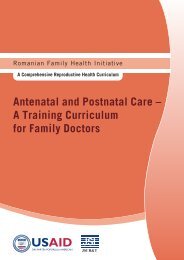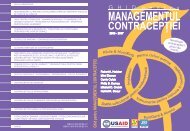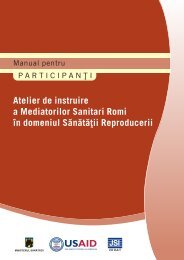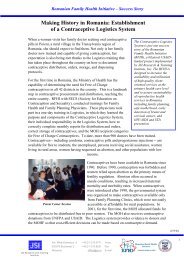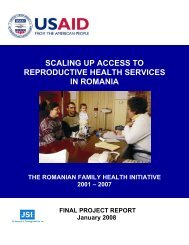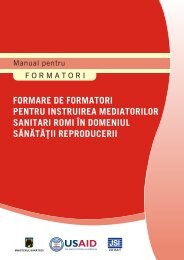Training of Roma Health Mediators in Reproductive Health
Training of Roma Health Mediators in Reproductive Health
Training of Roma Health Mediators in Reproductive Health
Create successful ePaper yourself
Turn your PDF publications into a flip-book with our unique Google optimized e-Paper software.
l<strong>in</strong><strong>in</strong>g like a pillow. If the girl/woman has had sex <strong>in</strong> the last few days before she<br />
ovulates, by the time the egg arrives <strong>in</strong> the fallopian tube, there may be some sperm<br />
wait<strong>in</strong>g to unite with the egg. If the arriv<strong>in</strong>g egg is united with the sperm (called<br />
fertilization), the egg travels to the uterus, and attaches to the l<strong>in</strong><strong>in</strong>g <strong>of</strong> the uterus<br />
(implantation) and rema<strong>in</strong>s there for the next n<strong>in</strong>e months, grow<strong>in</strong>g <strong>in</strong>to a baby. If the<br />
egg is not fertilized, then the uterus does not need the thick l<strong>in</strong><strong>in</strong>g it has made to protect<br />
the egg. The l<strong>in</strong><strong>in</strong>g is shed, along with some blood and the unfertilized egg. All <strong>of</strong> this<br />
flows through the cervix and then out <strong>of</strong> the vag<strong>in</strong>a. This flow <strong>of</strong> blood is called the<br />
“period” or menstruation.<br />
Ovulation is the release <strong>of</strong> a ripe egg from one <strong>of</strong> the ovaries once a month. This egg is<br />
picked up by the broad, funnel-shaped end <strong>of</strong> the Fallopian tube and starts mov<strong>in</strong>g <strong>in</strong><br />
the tube towards the womb. A woman can become pregnant only if: 1) she ovulates,<br />
and 2) the released egg is fertilized by a sperm after sexual <strong>in</strong>tercourse with a man.<br />
Usually only one egg is released dur<strong>in</strong>g ovulation. Sometimes, however, two eggs are<br />
released at the same time. If this happens and both are fertilized, tw<strong>in</strong>s will be born.<br />
Menstruation happens every month. When an egg ripens <strong>in</strong> the ovary, the <strong>in</strong>ner l<strong>in</strong><strong>in</strong>g<br />
<strong>of</strong> the uterus (womb) starts becom<strong>in</strong>g thick and spongy (due to <strong>in</strong>creased blood-supply)<br />
as it prepares to receive the fertilized egg. However, after ovulation, if the egg does not<br />
get fertilized, it dies. The uterus is “disappo<strong>in</strong>ted” that the “expected guest” will not<br />
come this month. So it sheds its <strong>in</strong>ner l<strong>in</strong><strong>in</strong>g and blood, which comes out <strong>of</strong> the<br />
woman’s body through vag<strong>in</strong>a as menstrual flow.<br />
This cycle is repeated every month. The period <strong>of</strong> time between a menstruation and the<br />
next one is called the menstrual cycle, with all these events tak<strong>in</strong>g place repeatedly.<br />
The length <strong>of</strong> the menstrual cycle varies from 21-40 days. The average length <strong>of</strong> the<br />
cycle is 28 days.<br />
Menstruation beg<strong>in</strong>s at puberty and cont<strong>in</strong>ues until menopause around age 45 to 50<br />
years. Then it stops forever because the ovarian function stops at that stage.<br />
Any bleed<strong>in</strong>g from the vag<strong>in</strong>a after menopause could be a sign <strong>of</strong> dangerous disease<br />
like cancer or a tumor <strong>of</strong> the uterus and should not be ignored.<br />
Fertilization takes place when a male sperm cell meets the female egg.<br />
Millions <strong>of</strong> sperm cells are deposited <strong>in</strong> the vag<strong>in</strong>a dur<strong>in</strong>g sexual <strong>in</strong>tercourse. After the<br />
male ejaculates (“comes”) <strong>in</strong> the vag<strong>in</strong>a, ejaculated sperm swim up through the cervix<br />
<strong>in</strong>to the uterus, and reach the Fallopian tubes seek<strong>in</strong>g an egg. If a mature egg is present,<br />
fertilization can take place. Although thousands <strong>of</strong> sperm may be present, only one<br />
sperm cell can penetrate the egg. Sperm can fertilize an egg up to seven days after<br />
<strong>in</strong>tercourse. The fertilized egg moves from the Fallopian tube <strong>in</strong>to the uterus (womb)<br />
where it will grow.<br />
Implantation occurs when the fertilized egg attaches to the l<strong>in</strong><strong>in</strong>g <strong>of</strong> the uterus. When<br />
this happens, the l<strong>in</strong><strong>in</strong>g rema<strong>in</strong>s throughout pregnancy, so menstruation stops.<br />
When the fertilized egg attaches to the l<strong>in</strong><strong>in</strong>g <strong>of</strong> the uterus, a thick and spongy organ<br />
called the placenta is formed. One side <strong>of</strong> the placenta is attached to the <strong>in</strong>side wall <strong>of</strong><br />
the womb. The other side is attached to the umbilical cord, which connects the<br />
placenta to the grow<strong>in</strong>g baby, called the “fetus”. He/she gets blood supply from the<br />
mother's body through the placenta. A bag <strong>of</strong> water surrounds the fetus and protects it<br />
from jerks, bumps and external <strong>in</strong>juries.<br />
34<br />
RFHI/JSI <strong>Roma</strong>nia <strong>Tra<strong>in</strong><strong>in</strong>g</strong> <strong>of</strong> RHMs <strong>in</strong> <strong>Reproductive</strong> <strong>Health</strong> Session 3: Human Reproduction



